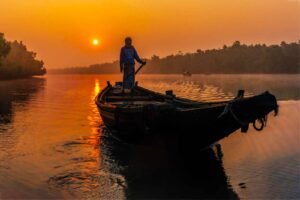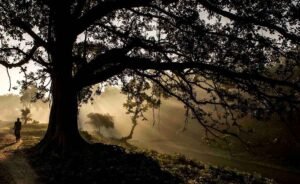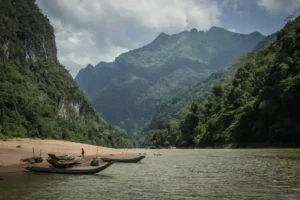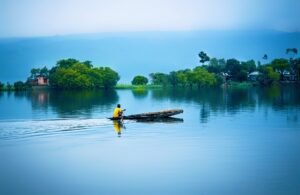Why you need to Travel in Bangladesh ? Home /...
Sundarbans Travel : Your Complete Guide - 2025
Sundarbans Travel : Your Complete Guide - 2025
I wanted to visit a place where I could lose myself among rivers and deep forests—a place where wildlife thrives in a lush, green world, and the morning chirping of birds rejuvenates the soul. A destination where every step feels like surrendering to the beauty of the sea, rivers, and verdant forests. I chose the Sundarbans to witness the majestic union of the blue sky, rivers, and forest.
Breaking free from the rigid confines of the bustling city, I boarded a bus one night, carrying just a small trolley bag. Our base in Mongla was Hotel Royal, from where we would begin our journey to the Sundarbans. Before setting out, we created a ‘trip plan’ in consultation with our guide.
Why sundarbans
The Sundarbans is the only internationally recognized natural tourist spot in Bangladesh and is often referred to as a natural wonder of the country. It is the largest mangrove forest or saltwater forest in the world.
The total area of the Sundarbans is about 10,000 square kilometers, spanning both Bangladesh and India. The Bangladesh portion covers an area of 6,017 square kilometers and includes parts of the Khulna, Satkhira, Bagerhat, Patuakhali, and Barguna districts. In 1997, UNESCO designated the Sundarbans as a World Heritage Site.
Rich in biodiversity, the Sundarbans is often described as a living museum of flora and fauna. It includes 1,874 square kilometers of rivers and streams, making it a significant wetland area.
The forest is home to a diverse range of species, including the iconic Royal Bengal Tiger, various bird species, chitra deer, crocodiles, and snakes. It boasts about 350 species of plants, 120 species of fish, 270 species of birds, 42 species of mammals, 35 reptiles, and 8 amphibians. The name Sundarbans is derived from the Sundari tree, a beautiful and significant species in this forest.
Best time to visit
November to February is the best time to visit the Sundarbans. During this period, the rivers and seas are calm, allowing tourists to explore all the attractions of the Sundarbans.
Karamjal and Harbaria, the closest tourist points to Khulna and Mongla, can be visited within a day at any time of the year. However, to experience the true essence of the Sundarbans, one must venture into the deeper areas, which cannot be covered within a single-day tour plan.
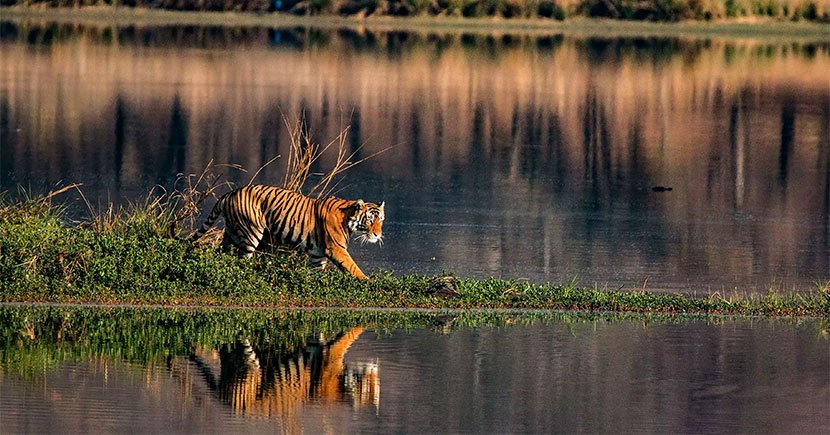
Sundarbans Tourist Attractions
It is a vast area with specific parts designated by the Forest Department for visitors. Sundarbans can be accessed through Khulna, Bagerhat, Satkhira, and Barguna, though most tourists prefer routes through Khulna and Mongla in Bagerhat.
Notable tourist attractions accessible from Khulna and Mongla include Karamjal, Harbaria, Kachikhali, Katka, Jamtala, Hiron Point, and Dublar Char.
- Karamjal:
The closest attraction to Mongla, Karamjal is primarily a deer and crocodile breeding center operated by the Forest Department. It features a wooden bridge trail that winds through the forest, allowing visitors to spot deer, crocodiles, monkeys, and various plant species. Even if one misses the opportunity to see wildlife in the deeper parts of the Sundarbans, Karamjal offers a delightful experience. - Harbaria:
Located about 20 kilometers from Mongla, Harbaria is a popular tourist spot in the Sundarbans. The main attraction is a wooden trail that takes approximately 30 minutes to walk. Visitors can explore a lotus pond and a watchtower that provides a panoramic view of Harbaria. Walking through the wooden bridge trail inside the forest is an adventurous and thrilling experience. - Katka:
Situated south of the forest station near the Bay of Bengal, Katka is known for its wildlife. Visitors can spot groups of wild deer within just a 15-minute walk along the trail in the Keora forest. Katka also features a wooden trail that offers an immersive forest experience. - Jamtala Beach:
Located near Katka, Jamtala Beach has an observation tower where visitors can take in the stunning scenery of the Sundarbans. If lucky, one might spot deer or tigers from the tower. A 3-kilometer walk from Jamtala Ghat leads to Jamtala Sea Beach, which boasts remarkable natural beauty. - Mandarbaria Beach:
Parts of Mandarbaria Beach remain relatively unexplored. This beach offers breathtaking views of both sunrise and sunset. To visit Mandarbaria, tourists need to access the Sundarbans via Satkhira. - Hiron Point:
Hiron Point’s beautiful wooden walkways provide a chance to observe deer, monkeys, gibbons, and crocodiles. Occasionally, lucky visitors may even catch a glimpse of the elusive Bengal tiger. - Dublar Char:
A small char in the Sundarbans, Dublar Char is where the river meets the Bay of Bengal. It is renowned for the Hindu holy bathing ritual, the Ras Mela, and its dry fish production. Between October and February, around 10,000 fishermen temporarily settle here to fish and dry their catch.
If you want to visit all these points in the Sundarbans, you need to plan for at least three days. Keep in mind that during these three days, you will stay on a travel ship, where all visitors spend the night, have meals, and enjoy other entertainment activities.
A Simple Day Tour Plan to the Sundarbans
If you have limited time to explore the Sundarbans, you can plan a day trip. Start by traveling from Dhaka to Mongla. From Mongla, you can visit the Karamjal or Harbaria tourist centers.
Leaving Mongla early in the morning allows you to cover both places in a single day. You can rent a boat for the entire day from Mongla Ferry Ghat. The cost for visiting Karamjal only ranges from 1,000 to 1,500 taka, while visiting both Karamjal and Harbaria will cost between 3,500 to 5,000 taka.
For visiting Harbaria, it is recommended to book a high-quality trawler and negotiate the fare in advance.
Entrance Fees:
- Karamjal:
- Domestic tourists: 20 taka per person
- Foreign tourists: 300 taka
- Domestic students: 20 taka
- Domestic researchers: 40 taka
- Foreign researchers: 500 taka
- Minors (under 12 years): 10 taka
- Domestic tourists using video cameras: 200 taka per camera
- Foreign tourists using video cameras: 300 taka per camera
- Note: A 15% VAT is applicable to all the above charges.
- Harbaria Eco Tourism Center:
- Domestic tourists: 70 taka per person
- Foreign tourists: 1,000 taka
- Note: A 15% VAT is applicable.
Enjoy the breathtaking natural beauty of the Sundarbans, even within a short visit!
Where to Stay
If you travel by ship or launch, accommodation facilities are available onboard. In fact, this is the best option to explore the Sundarbans deeply.
Additionally, if you travel individually, there are accommodation facilities at Kachikhali at Tiger Point, Nilkamal at Hiran Point, and the Forest Department Rest House at Katka in the Sundarbans.
For accommodation in Mongla, there are hotels run by the Tourism Corporation. Basic quality hotels for tourists are also available in Pashur Bandar.
In Khulna city, various quality residential hotels are notable, including Hotel Royal, Castle Salam, Hotel Tiger Garden, Hotel West Inn, Hotel City Inn, and Hotel Millennium.
If you prefer to stay in Satkhira city, there are some basic quality hotels. Overnight accommodations are also available at NGO Sushilan’s rest house and dormitory in Munshiganj, Shyamnagar.
Important note about travel into Sundarbans
- Permission from the Forest Department must be obtained at least three days in advance. Contact the tour operator at least five days before.
- In winter, you must wear heavy winter clothing.
- Have to stay far away from Locality. So, Tidy up the essential items and medicines.
- Must enter the Sundarbans with a team. The team must include a security guard of the forest department.
- Remember there is no mobile network Sundarbans.
- Biodiversity and nature should not be harmed.
- Please remain as silent as possible inside the forest.
- You should be aware of the use of plastic.
Sundarbans Journey – My experience
We make a 3 day’s plan to cover Sundarbans with journey by ship. here is my real life experience _
First day
We started our journey from Kallyanpur, Dhaka, to Khulna at 11:30 PM. Remember, the ideal starting point for a Sundarbans trip is Khulna. Regardless of your location, begin your journey from Khulna.
On the morning of December 3, 2024, at 5:30 AM, we arrived at Sheyalbari Mor, Khulna. From there, we went to Jelkhana Ghat to catch our ship, referred to as tourist vehicles. This is the starting point of the Sundarbans journey.
We started our journey by having breakfast in the canteen at the top of the ship. This three-day trip was completed aboard a ship fully stocked with food and snacks.
At 7 o’clock, we departed Jelkhana Ghat for the Harbariya point of the Sundarbans. Along the way, we crossed the Bhairab, Rupsha, and Poshur rivers before reaching Harbariya. On this route, we also saw the government project Rampal Thermal Power Plant and the Mongla Sea Port.
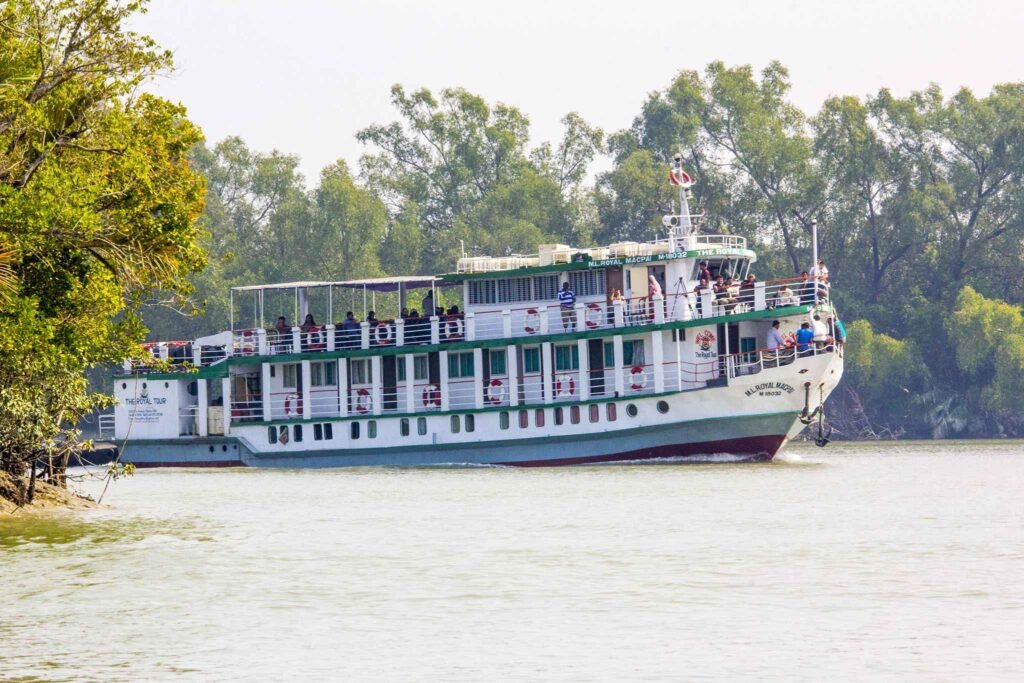
At 2:00 PM, the ship authorities announced, “Please come to the front of the ship, those who want to visit Harbariya Point.” Every ship has one or more trawlers to travel from the deeper parts of the river to the riverbank. Harbariya Point is 70 kilometers from Khulna and 12 kilometers from Mongla Port.
Harbariya Point
The guide announced, “We will stay here for 40 to 45 minutes before returning to the boat. Those who are unable to walk can remain seated in the designated sitting area. We will enter the forest as a team in a single line. Please do not walk into the forest alone. If you need to take photographs, do so while maintaining your position in line.”
The canal in front of Harbariya Point is known as the Sanctuary of Crocodiles. It is also home to rare species such as Maya deer, monkeys, rabbits, and other animals.
At the center of Harbariya, there is a wooden bridge, a watchtower, and beautiful ponds. It takes a minimum of 25 minutes to complete the trails of the wooden path, where you can see mangrove trees and their roots, various birds, and herds of deer. To avoid unknown dangers, always walk in a line.
The visit to the first spot of the Sundarbans on the first day is over. After two hours, we returned to the ship using a boat. The ship is now heading towards the second destination, Kotka Point. Meanwhile, we enjoyed the river view while having lunch.
Our ship arrived at Kotka Point at 11 PM, where another tourist ship was anchored beside ours. We will all stay here overnight. Early the next morning, before sunrise, we plan to visit Jamtala Sea Beach and Kotka Office Park. Afterward, our ship will sail to Dublar Char via Hiran Point.
Currently, all delegates are enjoying the buffet dinner.
Second day at Sundarbans
On the second day of the Sundarbans tour, we woke up very early in the morning, as announced by the guide the previous night. Delegates from other ships were also preparing to ride the boat to Kotka Jamtala Sea Beach.
We headed towards the sea beach, following the trails. Surrounded by deep forests, we moved along the path at the edge of the forest toward Jamtala Sea Beach. The fog enveloped us all around.
Kotka Jamtala Sea Beach
We enjoy the sunrise and the sea beach at Jamtala Point. It’s a beautiful creation of Almighty God in the world. On the sea beach, we see many uprooted trees, which were uprooted when Cyclone Sidr took place. At 8 o’clock in the morning, we return to the boat to go to the Kotka Sanctuary Center, Sharankhola Range. Here, we find a wooden trail that takes about 5 minutes to finish. After the trail, we may find a herd of deer. Let’s go.
Be careful of the monkeys at the Kotka Sanctuary Center; they are a little aggressive. After covering Kotka, we returned to the ship to head to Hiran Point. As the ship sails on the river, our breakfast sails along with it. If all goes well, we will reach Hiran Point by noon. Since the waves at Hiran Point are high, we wore life jackets and climbed up.
Hiran Point
Hiran Point is a protected area in the southern part of the Sundarbans. Its other name is Nilkamal Sanctuary Center. It is a famous place to see the Royal Bengal Tiger.
Apart from this, one can also see wild boar, cheetah, and various types of birds. After the tour, we left for Dublar Char at 5 pm. We went to Dublar Char to watch the sunset in the late afternoon. After getting off the boat, we walked for 5 minutes to the fishing village. We visited the dried fish market in Dublar Char. After sunset, we went back to the ship to head toward Koromjol Point. A light evening snack was being served. Today is our second and last night on our trip to the Sundarbans, so we are enjoying the last moments on our own terms.
There were various initiatives from the ship to make the moments memorable, such as a raffle draw, a song night, and sharing Sundarbans travel experiences.
Third day at Sundarbans
After breakfast on the third day, we waited for the announcement of the raffle draw results, which was really exciting. The gift was also surprising. Koromjol is the wild animal breeding center. As soon as you enter here, you see a huge map of the entire Sundarbans. Tiger footprints and crocodile eggs are also preserved here.
We buy chor shak, a type of grass, to feed the deer. When the deer come to us in search of food, we get the opportunity to touch them. Koromjol is the reserved area for breeding deer, tigers, and crocodiles. Keep your mobile safe from the monkeys of Koromjol. Be aware when taking photographs, as they can take your mobile phone and run off.
Our Sundarbans tour ended with a visit to Karamjal. After this, our ship started sailing toward Khulna Jail Ghat.
Conclusions
Sundarbans is a UNESCO World Heritage site and a national asset. Everyone should visit the Sundarbans to experience this natural wonder of Bangladesh. The Sundarbans is not only a natural wonder of Bangladesh but also a green shield against disasters. Visitors can collect honey from the Sundarbans, which is popular across the country. Additionally, visitors can buy locally handmade traditional household products as souvenirs to remember their visit.
8 Reason What Makes Winter So Special in Bangladesh
8 Reason What Makes Winter So Special in Bangladesh The...
Bangladesh Travel Guide – 2025
Home Bangladesh Travel Guide – 2025 Hi friends ! Are...
Best 5 Beaches in Bangladesh Will Blow Your Mind !
Best 5 Beaches in Bangladesh Will Blow Your Mind !...
Hakaluki Haor the Hidden Ocean of Bangladesh Will Leave You in Awe!
Discover the Hidden Ocean of Bangladesh: Hakaluki Haor Will Leave...
